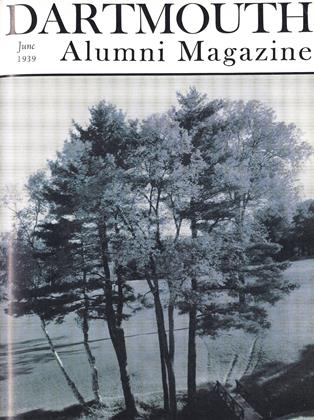by Shaw Livermore '22. TheCommonwealth Fund, New York, 1939.p. 327. $3.50.
About 1921 the Legal Research Committee of the Commonwealth Fund began to explore the field of administrative law. Out of these explorations have come a notable array of books, such as Freund's Administrative Powers Over Persons andProperty, Sharfman's definitive five volume study of the Interstate CommerceCommission, Dodd's Administration ofWorkmen's Compensation, and others. Branching out into other fields the latest of these excellent pieces of research is Early American Land Companies by Professor Shaw Livermore.
Professor Livermore is a keen student of the modern American corporation. Moreover, he has searched deeply into its past history. Out of an inquiry into the internal characteristics and legal status of unincorporated land companies in the Revolutionary period he has developed a theory of the origin of the modern business corporation. He arrives at conclusions that are not exactly orthodox.
The author examined with care a score or more of pre- and post-Revolutionary land companies. He found that the nature of land merchandising instituted requirements which we recognize today as corporate management. Business leaders of those days, having also recognized those requirements, fitted the form of organization to the occasion freely and spontaneously. Nor did they approach the legislatures for consent. Rather they reasserted the principle of free association without governmental approval. It is Professor Livermore's thesis that these early land companies are the real roots and forebears of the present day business orporation, more so than the semi-political (or quasi-public) chartered bodies which he describes as a branch of the corporation's family tree. He maintains that charter grants by state legislatures should not be considered the sole milestones marking the development of business enterprise prior to the general acts of incorporation of 1830 and thereafter. Business men of those times deemed incorporation as a right to be indulged in freely and not as a privilege to be granted or denied by legislatures.
The popular notion exists that the shift to general incorporation from the procedure of special enactment by legislative bodies was due in the main to the prevailing fear that monopoly was being fostered by legislative restriction of the privilege to a few and to the dissatisfactions with the awkwardness of the special procedure and its attendant political corruption. Professor Livermore does not deny the validity of these ideas but he does stress what he feels rightly to be far more important, viz., that legislative adjustment by general incorporation acts after 1830 was merely belated recognition of a de facto situation in the business world which business leaders had long recognized.
While Professor Livermore's book has special significance to those interested in history, economics, and the law, the general reader will find it interesting also. The chapters dealing with legislative vagaries and judicial inertia especially will provide food for thought in light of present day difficulties.
 View Full Issue
View Full Issue
More From This Issue
-
 Sports
SportsBig Green Teams
June 1939 By Whitey Fuller '37 -
 Class Notes
Class Notes1918*
June 1939 By ERNEST H. EARLEY -
 Article
ArticleThe Undergraduate Chair
June 1939 -
 Class Notes
Class Notes1929*
June 1939 By F. WILLIAM ANDRES -
 Article
ArticleHanover Browsing
June 1939 By HERBERT F. WEST '22 -
 Class Notes
Class Notes1930*
June 1939 By ALBERT I. DICKERSON
William A. Carter '20
-
 Books
BooksPROCEEDINGS OF THE FIRST ANNUAL NEW HAMPSHIRE BANK MANAGEMENT CONFERENCE. $1.00.
November 1940 By William A. Carter '20 -
 Books
BooksPROCEEDINGS OF THE THIRD NEW HAMPSHIRE BANK MANAGEMENT CONFERENCE
October 1942 By William A. Carter '20 -
 Books
BooksGOVERNMENT, BUSINESS AND VALUES,
October 1943 By WILLIAM A. Carter '20 -
 Books
BooksTHE MONETARY AND BANKING SYSTEM
October 1950 By William A. Carter '20 -
 Books
BooksTHE MONEY MARKET AND MONETARY MANAGEMENT.
MARCH 1965 By WILLIAM A. CARTER '20 -
 Class Notes
Class NotesPhoenix
December 1975 By WILLIAM A. CARTER '20
Books
-
 Books
BooksThe December 5 issue of Far Eastern
January 1946 -
 Books
BooksTalking Sense
JAN./FEB. 1978 By CHARLES M. WILTSE -
 Books
BooksWILLIAM E. CHANDLER, REPUBLICAN
February 1941 By CLAUDE N. FUESS -
 Books
BooksAfter the Big Bang
APRIL 1978 By DELO E. MOOK -
 Books
BooksA TAX PROGRAM FOR A SOLVENT AMERICA, >
December 1945 By Lloyd P. Rice -
 Books
BooksTHE SIOUX, Life and Customs of a Warrior Society.
JULY 1964 By ROBERT A. McKENNAN '25
William A. Carter '20
-
 Books
BooksPROCEEDINGS OF THE FIRST ANNUAL NEW HAMPSHIRE BANK MANAGEMENT CONFERENCE. $1.00.
November 1940 By William A. Carter '20 -
 Books
BooksPROCEEDINGS OF THE THIRD NEW HAMPSHIRE BANK MANAGEMENT CONFERENCE
October 1942 By William A. Carter '20 -
 Books
BooksGOVERNMENT, BUSINESS AND VALUES,
October 1943 By WILLIAM A. Carter '20

